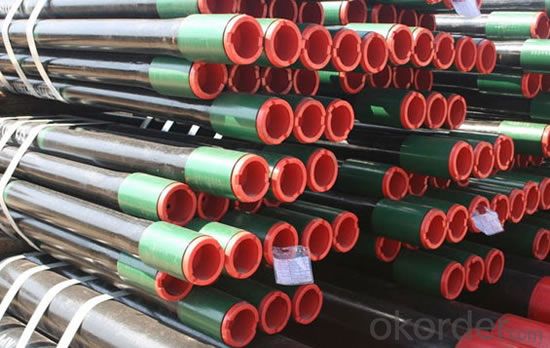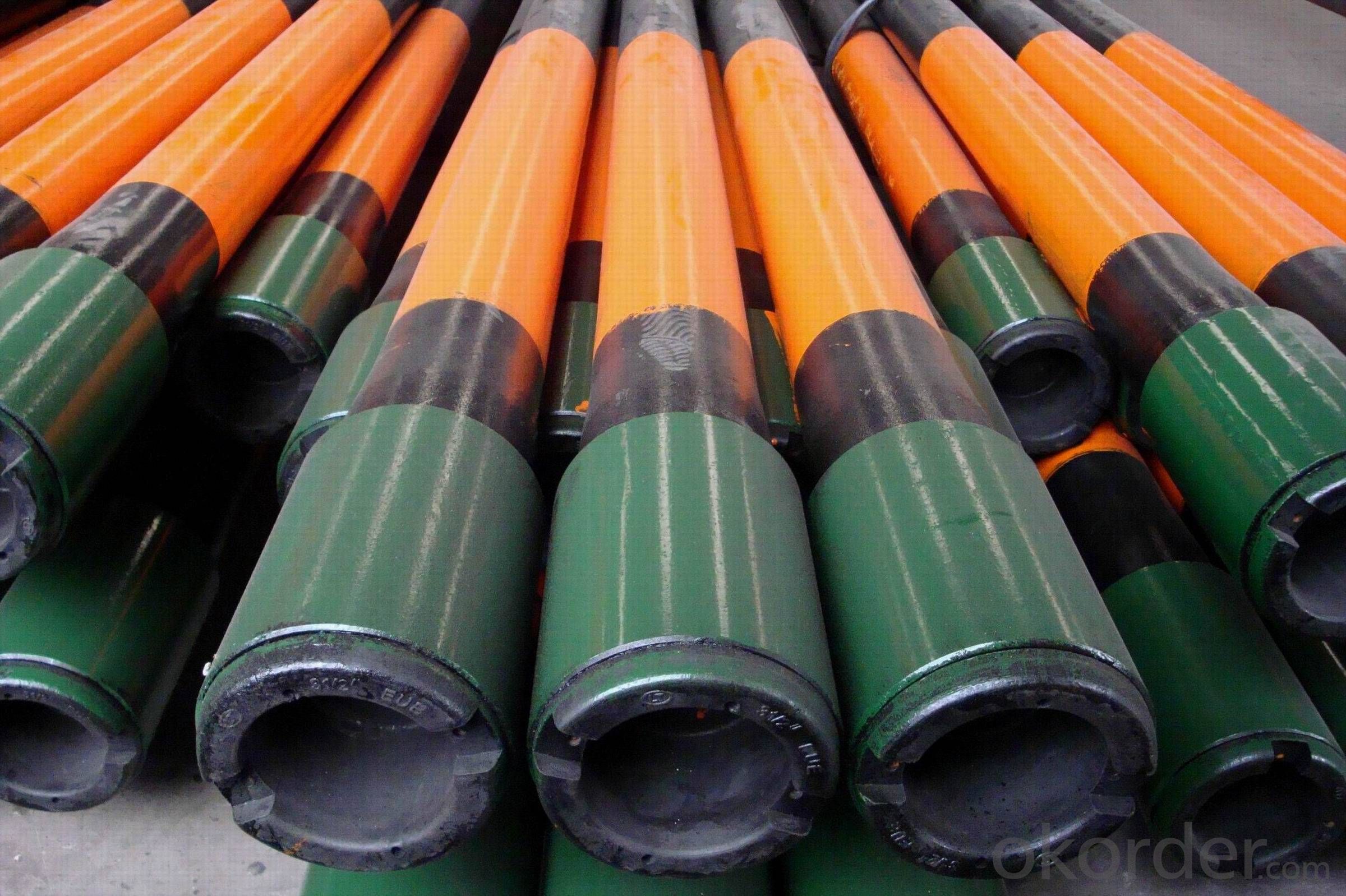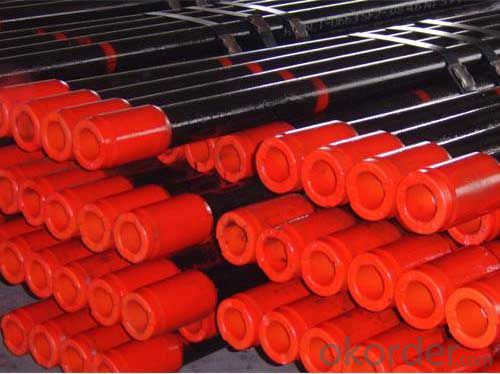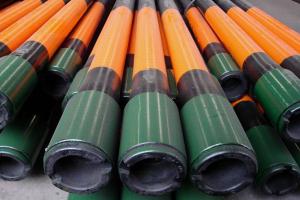API-5CT EUE Tubing Pipe
- Loading Port:
- Tianjin
- Payment Terms:
- TT OR LC
- Min Order Qty:
- -
- Supply Capability:
- 20000ton m.t./month
OKorder Service Pledge
OKorder Financial Service
You Might Also Like
API-5CT EUE Tubing Pipe
The API external-upset-end (EUE) tubing pipe is broadly used due to the fact that is a good, serviceable interconnection in the majority of wells.
Without the need of modifying the actual thread shape, the joint dimension will increase because of upsetting procedure. The EUE joint features a designed joint strength in tension and pressure strength much higher than that of the pipe overall body and, as a result, is considered a 100% joint effective connection.
To enhance seal efficiency of API EUE tubing in high-pressure system, a grooved coupling, which accepts nonmetallic seal rings, is quite often applied in the coupling (see API Spec. 5CT SR 13).
API EUE joints come in OD sizes of 1.050 to 4.500 inch.
| Parameters | Value | |
|---|---|---|
| Material | J55, K55, N80, N80Q, L80, P110, other grade available as your requirement | |
| Outer Diameter | 2-3/8"~4-1/2" (73.02~114.3mm) | |
| Wall Thickness | 4.83~16mm | |
| Forms of Thread | EUE, NUE and Integral-joint | |
| Length Range | R1(20~24ft), R2(28~32ft) | |
| MTR | accordance with API Specification 5CT |
Tolerances
| Parameters | Value | |
|---|---|---|
| Outside diameter | +-0.031 inch (0.79mm) | |
| Wall thickness | -12.5%, positive deviations are limited by pipe weight | |
| Weight Deviation | +6.5% /-3.5% |
Mechanical Properties
| Grade | Tensile Strength (PSI/MPa) | Yield Strenght (PSI/MPa) | ||
|---|---|---|---|---|
| H-40 | No less than 60000(414) | Between 40000 (276) ~ 80000 (552) | ||
| J-55 | No less than 75000 (517) | Between 55000 (379) ~ 80000 (552) | ||
| N-80 | No less than 100000 (689) | Between 80000 (552) ~ 110000 (758) | ||
| P-110 | No less than 125000 (862) | Between 110000 (758) ~ 140000 (965) |




Inspection
Physical properties are checked and each length hydrostatically tested, normally to only 3,000 psi in the plain end (unthreaded) condition. The following are also checked:
Dimensions
Weights
Straightness
Lengths
Part of this inspection is to drift all lengths.
Despite all the American Petroleum Institute (API) specifications and testing, some tubing defects are still found after delivery; thus, some operators do further inspection.
Inspection Method
Size and surface inspection
NDT and pressure test and third party certication
Hydrostatic
Drifting test
Physical and chemicail analysis
Hardness and pressure test.
Electromagnetic
Magnetic particle
Ultrasonic
Dimensions and Weight
sizes | ODD | weight | wtt | Type of end | |||||||||||
1 | 2 | NU kg/m | EU kg/m | IJ kg/m | |||||||||||
NU | EU | IJ | |||||||||||||
H40 | J55 | L80 | N80 1¸Qàà | C90 | T95 | P110 | |||||||||
1 | 2 | 3 | 4 | 5 | 6 | 7 | 8 | 9 | 10 | 11 | 12 | 13 | 14 | 15 | 16 |
2-3/82-3/82-3/8 | 4.004.605.80 | -4.705.95 | — | 60.3260.3260.32 | 5.956.858.63 | -6.998.85 | — | 4.244.836.45 | PUPNU- | PNPNU- | PNPNUPNU | PNPNUPNU | PNPNUPNU | PNPNUPNU | -PNUPNU |
2-7/82-7/82-7/8 | 6.407.808.60 | 6.507.908.70 | — | 73.0273.0273.02 | 9.5211.6112.80 | 9.6711.7612.95 | — | 5.517.017.82 | PNU– | PNU– | PNUPNUPNU | PNUPNUPNU | PNUPNUPNU | PNUPNUPNU | PNUPNUPNU |
3-1/23-1/23-1/2 | 7.709.2010.20 | -9.30- | — | 88.9088.9088.90 | 11.4613.6915.18 | -13.84- | — | 5.496.457.34 | PNPNUPN | PNPNUPN | PNPNUPN | PNPNUPN | PNPNUPN | PNPNUPN | -PNU- |
444 | 9.5010.7013.20 | -11.00- | — | 101.60101.60101.60 | 14.14-19.64 | -16.37- | — | 5.746.658.38 | PNPU- | PNPU- | PNPUP | PNPU- | PNPUP | PNPUP | — |
4-1/24-1/2 | 12.6015.20 | 12.75- | – | 114.30114.30 | 18.7522.62 | 18.97- | – | 6.888.56 | PNU- | PNU- | PNUP | PNU- | PNUP | PNUP | – |
4-1/24-1/24-1/2 | 17.0018.9021.50 | — | — | 114.30114.30114.30 | 25.3028.1332.00 | — | — | 9.6510.9212.70 | — | — | PPP | — | PPP | PPP | — |
P——Plain end;N—Non-upset threaded and coupled;U—External upset threaded and coupled;I—insert joint. | |||||||||||||||
Dalipal Company is one of the most famous enterprises of china professionally producing pipeline and oil casing.We can supply API 5CT series of pipeline and oil casing with all kinds of specifications and materials.We have first-class production equipment and technology.
- Q:Can steel pipes be used for wastewater treatment facilities?
- Yes, steel pipes can be used for wastewater treatment facilities. Steel pipes are commonly used in wastewater treatment plants due to their durability, strength, and resistance to corrosion. They can efficiently transport and distribute wastewater throughout the facility, ensuring its proper treatment and disposal. Additionally, steel pipes can withstand the harsh conditions and chemicals often present in wastewater treatment processes, making them a reliable choice for this application.
- Q:How do you calculate the pipe flow rate for steel pipes?
- To calculate the pipe flow rate for steel pipes, you will need to consider various factors. Firstly, determine the inside diameter of the pipe, typically denoted as D. Next, measure the length of the pipe, denoted as L. Additionally, you will need to know the pressure drop, ΔP, across the pipe and the fluid density, ρ. Once you have this information, you can use the Darcy-Weisbach equation or the Hazen-Williams equation to calculate the flow rate. The Darcy-Weisbach equation is commonly used for pipes with turbulent flow, while the Hazen-Williams equation is often used for pipes with laminar flow. For the Darcy-Weisbach equation, the formula is: Q = (π/4) * D^2 * √(2ΔP/ρ) Where Q is the flow rate in cubic meters per second, D is the inside diameter of the pipe in meters, ΔP is the pressure drop across the pipe in pascals, and ρ is the fluid density in kilograms per cubic meter. For the Hazen-Williams equation, the formula is: Q = C * (D^2.63) * (ΔP^0.54) * (L^0.63) Where Q is the flow rate in cubic meters per second, D is the inside diameter of the pipe in meters, ΔP is the pressure drop across the pipe in pascals, L is the length of the pipe in meters, and C is the Hazen-Williams coefficient which depends on the roughness of the pipe. To accurately calculate the pipe flow rate, it is important to ensure that the units of measurement are consistent throughout the calculation. Additionally, it is crucial to have accurate measurements of the inside diameter, length, pressure drop, and fluid density to obtain reliable results.
- Q:What is the pressure rating of steel pipes?
- The pressure rating of steel pipes can vary depending on factors such as the size, wall thickness, and specific grade of the steel used. However, steel pipes are commonly available in pressure ratings ranging from a few hundred PSI (pounds per square inch) to several thousand PSI, making them suitable for a wide range of applications.
- Q:Can steel pipes be used for bridge piling?
- Yes, steel pipes can be used for bridge piling. Steel pipes provide several advantages for bridge piling, such as high strength, durability, and resistance to corrosion. They can be driven deep into the ground to provide a stable foundation for the bridge structure, making them a suitable choice for bridge piling applications.
- Q:Is the electric pipe used with steel pipe or PVC pipe?
- When the electric wire pipe is laid, the steel pipe can be adopted, or the plastic pipe can be adopted, but the steel tube must not be used in the ceiling. The standard explanation is for rat bite.
- Q:Can steel pipes be used for oil refineries?
- Yes, steel pipes are commonly used in oil refineries due to their high strength, durability, and resistance to corrosion, making them suitable for transporting various petroleum products and chemicals within the refinery infrastructure.
- Q:What is the difference between black and galvanized steel pipes?
- The main difference between black and galvanized steel pipes lies in their coating. Black steel pipes are untreated and have a dark, uncoated appearance, while galvanized steel pipes are coated with a layer of zinc to prevent corrosion. This zinc coating on galvanized pipes helps protect against rust and extends their lifespan, making them suitable for outdoor and exposed applications. Black steel pipes, on the other hand, are typically used for indoor applications and are often painted or coated after installation to prevent rusting.
- Q:How seamless steel tube is formed?
- Overview of two kinds of steel pipe process:1, cold drawing (rolling) seamless steel pipe: round tube to heating to perforation, annealing, pickling, leading to oil (copper), multi pass drawing (Leng Zha), the blank pipe, heat treatment, straightening, pressure test (testing), marking and warehousing.2. Hot rolling (extrusion seamless steel tube): round tube billet, heating, piercing, three roll cross rolling, rolling or extrusion, removal of pipe, sizing, reducing (diameter or reducing), cooling, blank tube, straightening, water pressure test (or flaw detection), marking and warehousing.
- Q:What are the standard specifications for steel pipes?
- The standard specifications for steel pipes vary depending on the intended use and industry requirements. However, some common standard specifications include the pipe's size, wall thickness, material composition (such as carbon steel or stainless steel), and pressure ratings. Other specifications may include the pipe's shape, length, and surface finish. It is essential to consult relevant standards organizations, such as ASTM or ASME, to determine the specific standard specifications for steel pipes in a given application.
- Q:Are steel pipes suitable for use in automotive industries?
- Yes, steel pipes are suitable for use in automotive industries. They are known for their strength, durability, and resistance to high temperatures and pressure, making them an ideal material for various applications such as exhaust systems, fuel lines, and structural components in automobiles. Steel pipes also offer excellent corrosion resistance, ensuring long-lasting performance in harsh environments.
1. Manufacturer Overview |
|
|---|---|
| Location | |
| Year Established | |
| Annual Output Value | |
| Main Markets | |
| Company Certifications | |
2. Manufacturer Certificates |
|
|---|---|
| a) Certification Name | |
| Range | |
| Reference | |
| Validity Period | |
3. Manufacturer Capability |
|
|---|---|
| a)Trade Capacity | |
| Nearest Port | |
| Export Percentage | |
| No.of Employees in Trade Department | |
| Language Spoken: | |
| b)Factory Information | |
| Factory Size: | |
| No. of Production Lines | |
| Contract Manufacturing | |
| Product Price Range | |
Send your message to us
API-5CT EUE Tubing Pipe
- Loading Port:
- Tianjin
- Payment Terms:
- TT OR LC
- Min Order Qty:
- -
- Supply Capability:
- 20000ton m.t./month
OKorder Service Pledge
OKorder Financial Service
Similar products
New products
Hot products
Related keywords




























